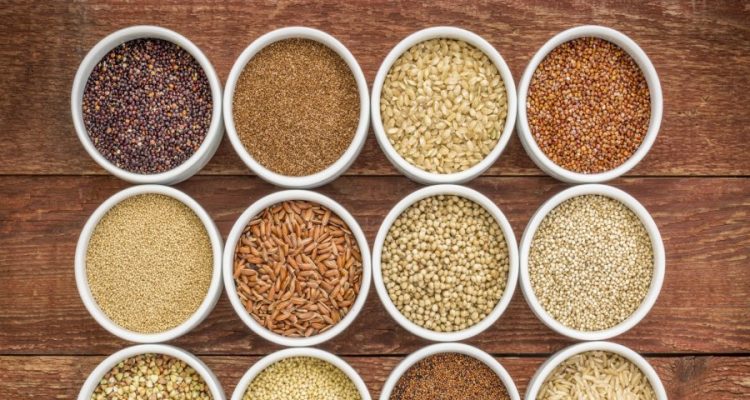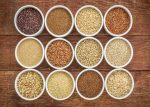
Going gluten free is an essential component of gut health for some, while others want to cut gluten from their diet to see if it improves any number of symptoms. But doing so can be very difficult. Grains are a major part of the North American diet and many others, and many grains contain gluten. But are grains gluten free? Thankfully, gluten-free grains exist and can be purchased for baking if needed.
Gluten refers to a class of proteins found in grains like wheat, barley, and rye. Grains are a source of important nutrients like carbohydrates, fiber, and B vitamins. Gluten-free grain options may have different consistencies, textures, and flavors than traditional baking grains and flour, but this can be overcome by mixing different gluten-free grains together.
Incorporating gluten-free whole grains into your diet is important if you have celiac disease or a gluten sensitivity because they are nutritionally dense.
According to the Gluten Intolerance Group, gluten-free products available in grocery stores are often made from cornstarch, potato starch, tapioca starch, or white rice flour. These options are not very nutritious, so electing whole grains and whole-grain flours can provide you with fiber and a variety of vitamins and minerals.
Grains: Gluten Free or Not?
The below table provides a list of the most common grains and their gluten content.
| Grains | Gluten Free |
| Amaranth | Yes |
| Rice | Yes |
| Buckwheat | Yes |
| Bulgur | No |
| Kamut | No |
| Millet | Yes |
| Oatmeal | Yes, but risky. See below. |
| Popcorn | Yes |
| Quinoa | Yes |
| Sorghum | Yes |
| Spelt | No |
| Teff | Yes |
| Barley | No |
| Cornmeal | Yes |
| Rye | No |
| Triticale | No |
Which Grains Are Gluten Friendly and Which Grains Are Not?
Some whole grains have gluten, while others do not. If you’re looking to reduce the amount of gluten in your diet, or if you have negative reactions to it, here is a list of whole grains to try, or to avoid.
1. Is Amaranth Gluten Free?
Amaranth powder is gluten free and has a nutty, slightly sweet flavor. The grain was a staple food in ancient Mexican civilizations such as the Aztec and Maya. It can be used to bake goods that are dark in color, like brownies. It’s also a decent source of protein, fiber, manganese, magnesium, phosphorous, and iron.
2. Is Rice Gluten Free?
Both brown, whole grain rice and white rice are naturally gluten free. Brown rice features more nutrition than white; however, white rice is far easier to digest. Because of the reactions brown rice can cause, many health professionals suggest eating white rice instead, and making up any missed nutrition in other areas.
You should also take care to buy rice products certified as gluten free, as cross-contamination with gluten is possible during farming, processing, and manufacturing stages.
3. Is Buckwheat Gluten Free?
Despite its name, buckwheat is gluten free and has a very bitter flavor that’s often compared to a hoppy-style beer (it’s even used to brew gluten-free beer). When roasted, it has an intense flavor, but even as a flour, it can add a degree of bitterness to baked goods.
It’s high in B vitamins and antioxidants and minerals like manganese and magnesium. Furthermore, one cup of cooked buckwheat groats contains just 1.5 grams (g) of sugar.
4. Is Bulgur Wheat Gluten Free?
Because it contains wheat, bulgur wheat does have gluten. If you’re looking for a gluten-free option, then it is not suitable. However, if you don’t have any trouble digesting gluten, it is a nutritious whole grain with protein, fiber, manganese, iron, and more.
5. Is Kamut Gluten Free?
Kamut is another alternative whole grain that is not gluten free. Kamut is nutrient dense and can contribute to a healthy diet in people who can digest gluten. It features fiber, protein, manganese, iron, zinc, and other valuable vitamins and minerals.
6. Is Millet Gluten Free?
Millet is a gluten-free whole grain with a sweet, nutty flavor. Like other whole grains, it is protein-and-fiber rich, acting as a great alternative to refined grains. It’s also a great source of B vitamins and minerals like manganese. Millet grains are popular in foods such as porridges and flatbreads, and in drinks like beer.
7. Is Oatmeal Gluten Free?
This is a popular question and can be a bit of a tough one to answer. In short, yes, oats are gluten free. But often, they are grown in the same fields as wheat products (all wheat products feature gluten). Sometimes remnants of the wheat can get into the oats and lead to gluten sensitivities in certain individuals. Again, it’s important to purchase brands labeled as “gluten-free,” or you can call the manufacturer to learn the production process.
8. Is Popcorn Gluten Free?
Corn in any form is gluten free, which is great news for the popcorn lovers out there. In fact, if you’re popping kernels in an air popper, it’s probably one of the healthiest snack foods you can eat. Popcorn is high in fiber and low in calories, especially if butter and other toppings are avoided.
Air popping popcorn at home and adding a little bit of seasoning or melted butter is a great way to enjoy a nutritious, gluten-free snack.
A 100-g serving of popcorn contains 56% of the recommended daily intake (RDI) of manganese, and 36% of the RDI of magnesium and phosphorus.
9. Is Quinoa Gluten Free?
This popular “whole grain” is actually a gluten-free seed, or pseudo-cereal, that’s rich in antioxidants, protein, and fiber. It is a great substitute for rice and a tasty addition to salad. It’s pretty easy to cook and accessible in most grocery stores.
10. Is Sorghum Gluten Free?
Sorghum is typically sold as a flour and has a nutty flavor. Being gluten free, it’s a good alternative for those interested in baking gluten-free treats. According to the USDA Agricultural Research Service National Nutrient Database, 100 g of the whole grain has 10.62 g of protein, 3.36 milligrams (mg) of iron, 0.443 mg of vitamin B6, and 3.688 mg of niacin.
11. Is Spelt Gluten Free?
Spelt is a distinct form of wheat and therefore contains gluten. It will cause trouble for people who have difficulty digesting gluten. It is a nutritious whole grain for those looking to increase their whole grain intake, however, and is a rich source of fiber, protein, manganese, and other vitamins and minerals.
12. Is Teff Gluten Free?
Teff is a gluten-free whole grain that’s been classified as a potential “super grain.” It’s a grain about the size of a little poppy seed that hails from Ethiopia. Like every other whole grain, it’s rich in a variety of nutrients (i.e. fiber, protein, calcium, iron, and B vitamins) and can be found in a number of forms—from bars to pancake mixes.
13. Is Barley Gluten Free?
Any type of barley, just like wheat, has gluten. As such, products made with barley will have gluten. There is some discourse over whether or not barley grass has gluten—the gluten is found in seeds—but it’s recommended that people with celiac disease or gluten sensitivities avoid the risk.
14. Is Cornmeal Gluten Free?
Cornmeal, like all corns, is also gluten free. It’s rather coarse, so corn flour can be used as a finer alternative for baking. It’s worth noting that corn pops up in all kinds of products and there’s a good chance it’s a GMO (genetically modified organism). If this is an issue for you, it may be worthwhile looking into other gluten-free, whole-grain alternatives.
A 3.5-ounce serving of cornmeal contains 9.4 g of fiber (at least a quarter of the recommended daily amount for adult men and women), 3 mg of iron, 3.1 mg of zinc, and 2.5 mg of niacin.
15. Is Rye Gluten Free?
Like wheat and barley, rye is another whole grain that features gluten and should be avoided by people with celiac disease and gluten sensitivities. For people without gluten sensitivities looking for whole-grain breads and flours, rye is a very healthy and tasty option.
One cup of dark rye flour contains over 20% of the daily recommended amounts of potassium, niacin, thiamine, vitamin B6, iron, zinc, magnesium, and phosphorus.
16. Is Triticale Gluten Free?
Triticale is a hybrid of rye and wheat, so it is most definitely not gluten free. It offers many of the same nutritional and health benefits of other whole grains; however, it is an entirely man-made crop. In fact, it is the first man-made crop species ever and is produced by crossing wheat and rye genes.
Triticale is especially high in an amino acid called lysine, which is important for building muscles and collagen as well as calcium absorption. Studies suggest it may also help manage the symptoms of various forms of the herpes simplex virus.
Final Thoughts on Gluten-Free Whole Grains
Whole grains are a great alternative to processed, refined grains and offer superior nutrition in the form of fiber, protein, B vitamins, and minerals like magnesium and manganese. Therefore, they have the potential to improve health.
Whole grains, however, are not always gluten free. People looking to manage chronic digestive conditions or a gluten sensitivity or intolerance need to be mindful when selecting whole-grain options. Refer to our list above the next time you make a trip to the grocery store.
Also read:
- Understand the Complete Difference Between Porridge & Oatmeal
- Pasta vs Rice: Differences in Nutrition and Health Benefits
- Quinoa vs Rice: Know the Difference in Nutrition and Benefits
- 13 Barley Water Benefits: How Much to Drink in a Day?
Sources:
See, J., RDN, LD, “Gluten-free? Try these delicious alternatives to wheat flour,” Mayo Clinic, December 10, 2016; https://www.mayoclinic.org/healthy-lifestyle/nutrition-and-healthy-eating/in-depth/gluten-free-try-these-delicious-alternatives-to-wheat-flour/art-20269952, last accessed April 20, 2018.
“Grains,” Coeliac UK; https://www.coeliac.org.uk/gluten-free-diet-and-lifestyle/gf-diet/grains/, last accessed April 20, 2018.
“Whole grains,” Gluten, last updated October 5, 2017; https://www.gluten.org/resources/diet-nutrition/whole-grains/, last accessed April 20, 2018.
“Is It Gluten Free?” Beyond Celiac; https://www.beyondceliac.org/gluten-free-diet/is-it-gluten-free/, last accessed April 20, 2018.













